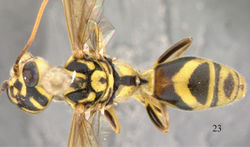Trigonalys maculifrons
| Notice: | This page is derived from the original publication listed below, whose author(s) should always be credited. Further contributors may edit and improve the content of this page and, consequently, need to be credited as well (see page history). Any assessment of factual correctness requires a careful review of the original article as well as of subsequent contributions.
If you are uncertain whether your planned contribution is correct or not, we suggest that you use the associated discussion page instead of editing the page directly. This page should be cited as follows (rationale):
Citation formats to copy and paste
BibTeX: @article{Smith2012JournalofHymenopteraResearch29, RIS/ Endnote: TY - JOUR Wikipedia/ Citizendium: <ref name="Smith2012Journal of Hymenoptera Research29">{{Citation See also the citation download page at the journal. |
Ordo: Hymenoptera
Familia: Trigonalidae
Genus: Trigonalys
Name
Trigonalys maculifrons Sharp – Wikispecies link – Pensoft Profile
- Trigonalys maculifrons Sharp 1895[1]: 564, fig. 371.
Discussion
This species is mostly yellow with various black maculations on the head and body (Fig. 23). The specimens reared from Costa Rica resemble this species with very similar black markings on the head and mesosoma. The black on the metasoma, however, differs. It is possible this is species-level variation, but we do not have enough specimens to evaluate this, and it does not seem to justify the description of a new species. Trigonalys flavescens Bischoff 1951, described from Mexico, is similar, but it differs by the more weakly striped metasoma and lack of a triangular mark at the top of the gena.
As explained by Carmean and Kimsey (1998)[2], Sharp (1895)[1] illustrated Trigonalys maculifrons with the caption “Trigonalys maculifrons Cam., i.l. Mexico” prior to Cameron’s (1897) description of the species. The illustration clearly depicts the holotype specimen described in Cameron, and Sharp is therefore the author of the species.
The Trigonalys maculifrons DNA barcode is 13–17% different from other ACG Trigonalidae.
Distribution
Costa Rica, Guatemala, Honduras, Mexico (Carmean and Kimsey 1998[2]).
Specimens examined
4; 4 DNA barcoded. Deposited in USNM, INBio.
Hosts and biology
This striking species has been reared just three times, all in 2001 and in ACG dry forest (Sector Santa Rosa), from caterpillars of Euscirrhopterus poeyi Grote (Noctuidae) feeding on Pisonia aculeata L. (Nyctaginaceae) and primary parasitized by Lespesia posticaDHJ01 (Tachinidae).
Taxon Treatment
- Smith, D; Janzen, D; Hallwachs, W; Smith, M; 2012: Hyperparasitoid wasps (Hymenoptera, Trigonalidae) reared from dry forest and rain forest caterpillars of Area de Conservación Guanacaste, Costa Rica Journal of Hymenoptera Research, 29: 119-144. doi
Other References
- ↑ 1.0 1.1 Sharp D (1895) Insects. In: Harmer S Shipley A (Eds) Cambridge Natural History, Vol. 5. MacMillan & Co., London, 83–584.
- ↑ 2.0 2.1 Carmean D, Kimsey L (1998) Phylogenetic revision of the parasitoid wasp family Trigonalidae (Hymenoptera). Systematic Entomology 23: 35-76. doi: 10.1046/j.1365-3113.1998.00042.x
Images
|
